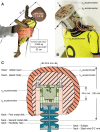Violent Infant Surrogate Shaking: Continuous High-Magnitude Centripetal Force and Abrupt Shift in Tangential Acceleration May Explain High Risk of Subdural Hemorrhage
- PMID: 34223553
- PMCID: PMC8240836
- DOI: 10.1089/neur.2021.0013
Violent Infant Surrogate Shaking: Continuous High-Magnitude Centripetal Force and Abrupt Shift in Tangential Acceleration May Explain High Risk of Subdural Hemorrhage
Abstract
Violent shaking is believed to be a common mechanism of injury in pediatric abusive head trauma. Typical intracranial injuries include subdural and retinal hemorrhages. Using a laboratory surrogate model we conducted experiments evaluating the head motion patterns that may occur in violent shaking. An anthropomorphic test device (ATD; Q0 dummy) matching an infant of 3.5 kg was assembled. The head interior was equipped with accelerometers enabling assessment of three-axial accelerations. Fifteen volunteers were asked to shake the surrogate vigorously holding a firm grip around the torso. We observed the volunteers performing manual shaking of the surrogate at a median duration of 15.5 sec (range 5-54 sec). Typical acceleration/deceleration patterns were produced after 2-3 shakes with a steady-state shaking motion at a pace of 4-6 cycles (back and forth) per second. Mean peak sagittal tangential accelerations at the vertex were 45.7g (range 14.2-105.1g). The acceleration component in the orthogonal direction, the radial acceleration, fluctuated around a negative mean of more than 4g showing that the surrogate head was continuously subjected to centripetal forces caused by rotations. This surrogate experiment showed that violent shaking may induce high peak tangential accelerations and concomitantly a continuous high-magnitude centripetal force. We hypothesize that the latter component may cause increased pressure in the subdural compartment in the cranial roof and may cause constant compression of the brain and possibly increased stretching or shearing of the bridging veins. This may contribute to the mechanism accountable for subdural hematoma in abusive head trauma.
Keywords: abusive head trauma; biomechanical model; infant; injury; shaken baby.
© Arne Stray-Pedersen et al., 2021; Published by Mary Ann Liebert, Inc.
Conflict of interest statement
Drs. Stray-Pedersen and Rognum have testified in courts of law regarding abusive head trauma.
Figures



Similar articles
-
Biomechanical Response of the Infant Head to Shaking: An Experimental Investigation.J Neurotrauma. 2017 Apr 15;34(8):1579-1588. doi: 10.1089/neu.2016.4687. Epub 2017 Jan 19. J Neurotrauma. 2017. PMID: 27931172
-
Experimental analyses of the retinal and subretinal haemorrhages accompanied by shaken baby syndrome/abusive head trauma using a dummy doll.Injury. 2014 Aug;45(8):1196-206. doi: 10.1016/j.injury.2014.04.014. Epub 2014 Apr 16. Injury. 2014. PMID: 24810668
-
Cyclic Head Rotations Produce Modest Brain Injury in Infant Piglets.J Neurotrauma. 2017 Jan 1;34(1):235-247. doi: 10.1089/neu.2015.4352. Epub 2016 May 11. J Neurotrauma. 2017. PMID: 26953505 Free PMC article.
-
Bridging veins and autopsy findings in abusive head trauma.Pediatr Radiol. 2015 Jul;45(8):1126-31. doi: 10.1007/s00247-015-3285-0. Epub 2015 Feb 20. Pediatr Radiol. 2015. PMID: 25698365 Review.
-
Thresholds for the assessment of inflicted head injury by shaking trauma in infants: a systematic review.Forensic Sci Int. 2020 Jan;306:110060. doi: 10.1016/j.forsciint.2019.110060. Epub 2019 Nov 18. Forensic Sci Int. 2020. PMID: 31785511
Cited by
-
Does High-Magnitude Centripetal Force and Abrupt Shift in Tangential Acceleration Explain High Risk of Subdural Hemorrhage?Neurotrauma Rep. 2022 Jul 15;3(1):248-249. doi: 10.1089/neur.2022.0025. eCollection 2022. Neurotrauma Rep. 2022. PMID: 35982982 Free PMC article. No abstract available.
-
An Update to Biomechanical and Biochemical Principles of Retinal Injury in Child Abuse.Children (Basel). 2024 May 12;11(5):586. doi: 10.3390/children11050586. Children (Basel). 2024. PMID: 38790581 Free PMC article. Review.
-
Tangential cranial gunshot wound in an infant in historical context: illustrative case.J Neurosurg Case Lessons. 2022 Mar 14;3(11):CASE227. doi: 10.3171/CASE227. Print 2022 Mar 14. J Neurosurg Case Lessons. 2022. PMID: 36209403 Free PMC article.
-
Inflicted head-injury by shaking-trauma in infants: the importance of spatiotemporal variations of the head's rotation center.Sci Rep. 2023 Sep 14;13(1):15226. doi: 10.1038/s41598-023-42373-x. Sci Rep. 2023. PMID: 37709812 Free PMC article.
-
Clinical and Forensic Investigation Protocols for Diagnosing Abusive Head Trauma: A Literature Review.Diagnostics (Basel). 2023 Sep 29;13(19):3093. doi: 10.3390/diagnostics13193093. Diagnostics (Basel). 2023. PMID: 37835835 Free PMC article. Review.
References
-
- Christian, C.W., Block, R., Committee on Child Abuse and Neglect, and American Academy of Pediatrics. (2009). Abusive head trauma in infants and children. Pediatrics 123, 1409–1411 - PubMed
-
- Berger, R.P., Fromkin, J.B., Stutz, H., Makoroff, K., Scribano, P.V., Feldman, K., Tu, L.C., and Fabio, A. (2011). Abusive head trauma during a time of increased unemployment: a multicenter analysis. Pediatrics 128, 637–643 - PubMed
-
- Choudhary, A.K., Servaes, S., Slovis, T.L., Palusci, V.J., Hedlund, G.L., Narang, S.K., Moreno, J.A., Dias, M.S., Christian, C.W., Nelson, M.D., Silvera, V.M., Palasis, S., Raissaki, M., Rossi, A., and Offiah, A.C. (2018). Consensus statement on abusive head trauma in infants and young children. Pediatr. Radiol. 48, 1048–1065 - PubMed
-
- Herman, B.E., Makoroff, K.L., and Corneli, H.M. (2018). Abusive head trauma. Pediatr. Emerg. Care 27, 65–69 - PubMed
-
- Adamsbaum, C., Grabar, S., Mejean, N., and Rey-Salmon, C. (2010). Abusive head trauma: judicial admissions highlight violent and repetitive shaking. Pediatrics 126, 546–555 - PubMed
LinkOut - more resources
Full Text Sources
Research Materials
